THE MARBLE AND THE STONE IN THE CONTEMPORARY ERA
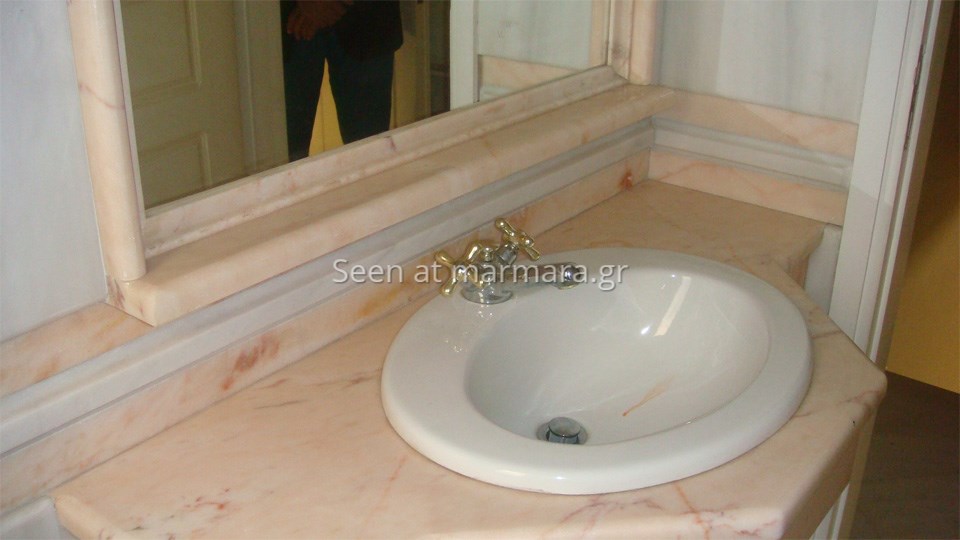
Marble Marble and stone, materials used extensively in the past in architecture, have begun to conquer the decorators, architects and builders again and to take the status they deserve among other building materials. Thus, marble is once again the protagonist in the building industry and its superiority in strength, maintenance, and even its cost compared to other competitive materials is no doubt unquestionable. In addition, its beauty, its natural colors and its ability to "aesthetically" match with other materials and decorative elements, are increasingly recognized by the architectural world as well as by the individuals as they often choose the structural materials for the construction of their home.
The course to regain the trust of customers to marble was long and difficult, considering that this material was considered for several decades not easily accessible and expensive, suitable only for super-constructions and therefore inaccessible to the economic potential of the average citizen. In addition, its extensive use in burial monument constructions has established it in the consciousness of many people as a material that recalls only unpleasant events. It took a long time to overcome these perceptions and of course a great deal of effort on the part of marble businesses to convince architects and builders that they can fully trust marble and not only in classical applications (investment, flooring, stairs) but also in the manufacture of furniture, artifacts and ornaments. This is because, in the field of artistic processing, marble has proven that it can satisfy the strict demands of designers and decorators.
Each artist requires the material he uses not to betray his taste, imagination and aesthetic stimuli, but rather to show his art suggestion with intensity and realism. This ability has marble, which is recognized by many decorators and builders who have never been betrayed by this material in one of its applications. Moreover, the parallel development of technology in the mining, cutting, processing, finishing and various applications of marble has played a decisive role in the search for the material, since manufacturers now have all the necessary means to implement an architectural proposal unrealized in other eras.
Today, the applications of marble and stone in various constructions are unlimited. Durable and luxurious marble floorings impressively decorate any space in simple homes, office buildings, banks, hotels and churches and are one of the major applications in modern building. Also, more and more internal and external ladders and ornaments are being made of marble, and we have examples of aesthetically flawless application in interior decoration.
Today, there are all the prerequisites for conquering the marble even bigger share in the international and domestic building materials market. But it must not stop the struggle for its promotion and the application of proper advertising, because marble faces sharp competition from other materials such as wood, ceramic tiles and other synthetic building materials, which are often preferred although its aesthetic is not questioned value. This is because there is insufficient or poor information about its physical and mechanical properties and the ability to fulfill any construction requirement.
Interior decoration, other than surface coatings, includes any element that can be added to the room and improve the aesthetic effect. Marble in this case, either as a piece of furniture or as a simple bench or as a decorative object, if used correctly, can offer wonderful solutions and change the look of a space. The very beautiful natural colors of the material can be combined with each other or with the color of other materials and create a warm atmosphere. Therefore, the use of marble and stone for the decoration of a space can produce wonderful results, as long as the proportion of their colors in place is observed.
With marbles and other decorative rocks, a lot of color can be added to a place, whether it be a shop or a home, creating a more pleasant and impressive environment. Particularly in the case of homes, where most are interested in high-quality construction, decorative rocks are now widely used. This is because the home is treated as a place where people seek the security and warmth they can not find in the outside social environment. On the other hand, a good quality home becomes the place where man decides to live his whole life. That is why the choice of building materials and interior decoration materials is now also based on their durability over time.
If one adds to all of this and the fact that modern man uses the environment of his home as a means of personal projection and appreciation in the social environment, it is natural to look for natural durable materials characterized by some originality and peculiarity, material as marble And other decorative stones. Some of the main applications of marble and other decorative rocks in modern constructions are described below:
A. Flooring
The use of decorative rocks on the flooring (indoor or outdoor) is widespread and there are impressive applications in luxury or simple, private or public constructions that are really masterpieces of art. At the same time, the need for specifications for the construction of flooring with marbles or other decorative rocks has been created to ensure above all the safety of the construction. Unfortunately, such standards in our country have not been established so far, resulting in many substandard practices..
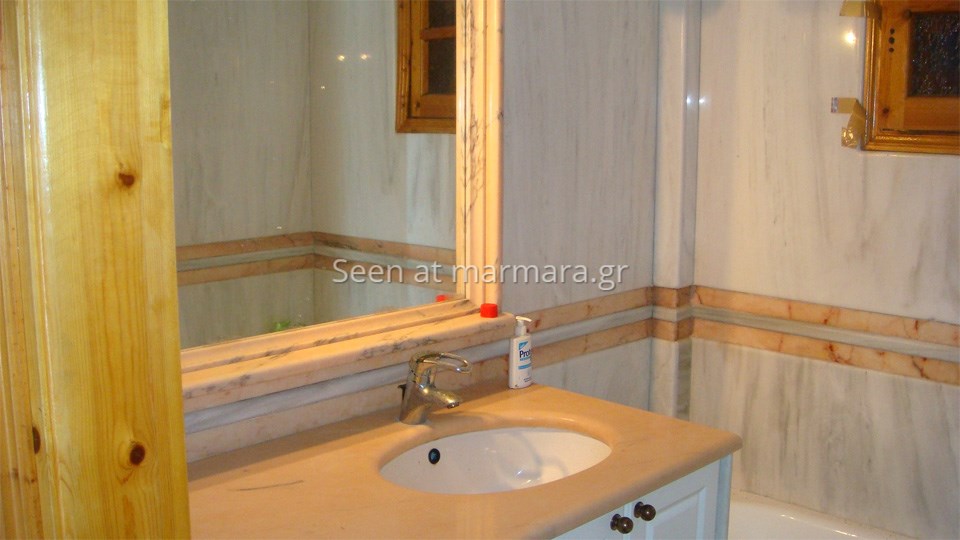
Combining two or more types of marble, granite or other stone, the manufacturer can "play" with colors and designs and offer high aesthetics, durable and glamorous with unique natural beauty. Several varieties of decorative rocks are suitable for floorings, mainly indoor. The choice of material is made according to the application for which it is intended, based on its physico-mechanical properties, which essentially determine its behavior in a particular space. It is known that floors can be corrupted and deteriorate significantly depending on the space and frequency of use. Thus, the natural rocks used on the floorings should be particularly resistant to surface friction, whereas when two or more different types of marbles are used to create a decorative composition in the flooring, the marbles should have the same degree of hardness and the hardness is Uniform throughout their surface. Additionally, certain tests such as e.g. For impact resistance, compressive strength, abrasion resistance etc.
B. Indoor investment
In the interior decoration, marble and other natural rocks are materials that can respond perfectly to all aesthetic requirements and combine marvelously with wood, glass or any other material to give impressive compositions. Here, because the material is not affected by weather conditions, its aesthetic features such as color with its various tones, vein patterns, etc. are important. For this reason, marbles with natural defects can also be used to decorate interiors, but they are carefully repaired before or after the plates have been laid. There are many examples of interior investment used with the use of marbles of high decorative value, but with very little consistency. These marbles are usually repaired and placed on the surfaces to be coated with suitable adhesives, as well as with special supports. Thus, in this area of application of decorative rocks there are no particular limitations and all types of marbles, granites and related rocks can be used, even the colored marbles that have absolute homogeneity.
The rock plates used in the interior linings have the surface shiny and polished and the other of the rough with elongated grooves facilitating welding and holding on the surface to be coated. The joints between the plates are usually closed, which requires careful control of the plates in terms of their dimensions, rectangular shape and flatness of their surfaces. In most cases the joints are contiguous both in the horizontal and the vertical sense.
When the plates have uniform veins, they can be combined with normal symmetry. When the marbles are intersected by abundant ridges, elaborate patterns on the surface of the wall such as diamonds or other symmetrical shapes can be created. Also, wonderful compositions can be achieved by plates of different sizes or even small pieces of marble. The marble slabs used in interior linings typically have a thickness of 6 to 20mm.
C. Hygienic spaces
In ancient times the baths of the Egyptians, Greeks and Romans were magnificent and luxurious. Today, we seem to come back to that old notion that wanted the luxurious bathroom room rather than an inconvenient and cold place. Thus, the market is flooded with a wide variety of quality materials for bathrooms such as ceramic tiles and marbles, as well as other decorative elements.
Among these materials, marble in large slabs or small tiles, holds a special place to cover the surfaces. With its variety of colors and its great durability it is very ideal material for creating a pleasant and cheerful bathroom. However, marble is not only used for floor and wall tiles in the bathroom. It is a wonderful material for the construction of impressive washbasins, benches, shelves and others. Water, humidity and temperature changes that characterize the conditions in the bathroom area require careful selection of materials. Marble, as a natural material, behaves perfectly in these circumstances, and is therefore reasonably considered the best material for such spaces.
D. Fireplaces
The decoration of the stone fireplace dates back to the Renaissance. Famous sculptors and architects have excelled as designers and manufacturers of fireplaces, using stone for their creations. Today, marble and stone remain the basic lining materials for the fireplaces and satisfy the aesthetic and decorative needs of the user in the best possible way.
White and colored marbles, travertine, limestone, granite, even onyx, are the most used materials and can give impressive constructions that blend wonderfully with the rest of the interior decoration, creating a perfect inner set. In addition to the luxurious structures, there are more simple stone fireplaces with more freedom and variety in the frescoes and decoration. In the market stores you can find a huge variety of fireplaces that can give excellent architectural solutions to those who are engaged in interior decoration.
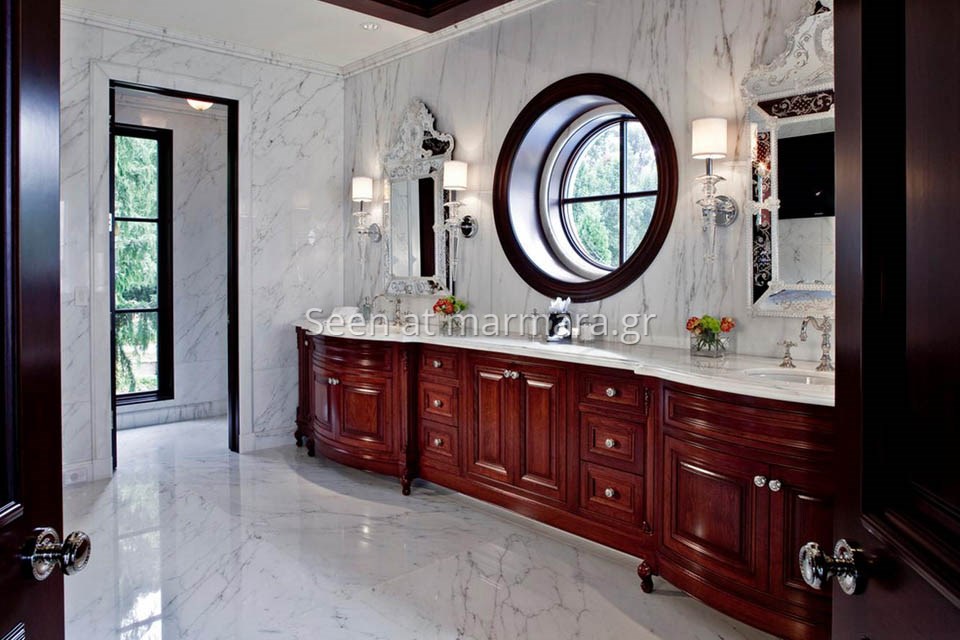
The rise in living standards, coupled with advances in stone processing technology that led to lower cost accounts, made the stone fireplace accessible to more people, redefining it as an emblem of home and family, a symbolism that has remained unchanged since antiquity .
E. Stairs
The functionality, durability and luxury of natural rock are rarely concentrated in one single material. And the stairs, which by nature serve a specific purpose and are not just items that are placed in a space to complement their decoration, have an absolute need of the above three properties. However, not all natural rocks are suitable for use in the construction of a ladder. Because the stairs are corroded and worn quickly by intense use, the rocks used for their construction should be particularly resistant to surface friction.
Also, for the choice of rocks intended for such applications, impact resistance, bending strength and frost resistance after frost should be considered. In particular, the latest test must be carried out on rocks that are to be used for outdoor stairs as they are directly exposed to weather conditions and possible sudden temperature changes. Also, when the ladder is made without ridges, with presses supported by metal or other construction, the marble to be used must have a very high bending strength..
Finally, stairs are very easy to dirty because of frequent use, compact and homogeneous rocks must be selected as much as possible. Of course, on stairways where the traffic is limited and the stairs are protected by carpets, the criteria for selecting natural rocks are more flexible and the restrictions, especially for the construction of the rails and the sides of the ladder, do not apply.
Marble is a material widely used in the construction of a staircase, external or internal. Architects and decorators have at their disposal a wide variety of marbles that can use and succeed in time-consuming and at the same time strikingly aesthetic design. Today, there are beautiful constructions that combine the perfect aesthetics with the solidity and safety that marble offers, both in modern and classical traditional constructions, has proven to be superior to other materials such as metal and wood.
In terms of the color of marbles, it is usually the open shades, both aesthetically and practically, because darker marbles fade in the areas where they get the most damage from the passers-by, resulting in an unsightly staining after the passage a few months from the construction of the ladder.
F. Furniture
Designers and furniture makers have returned to marble and stone with new ideas. They present stone furniture with a modern line and new shapes, with vivid and intense colors that can offer exceptional decorative solutions to the modern home.
Leaders in this field are Italian designers, without saying that there are no gorgeous Greek designs of stone furniture. Many creators have escaped from the classic patterns and give the stone furniture a new functionality. In many cases marble is combined with other materials such as glass, metal, wood (lacquered or not) with impressive results. In other cases, there is a strong sensitivity to anything old, resulting in the manufacture of elegant stone furniture as replicas of eg. Ancient Roman tables with central leg - bracket, consoles of Louis XV of 16th and others.
Also, beautiful tables for cafes are created with marble slabs and metal legs, but adapted to the principles of modern design. Still, it is fashionable old objects of everyday use to be incorporated into modern furniture such as The metal legs of an old sewing machine can, along with a white marble slab, give a remarkable piece of furniture. The marble furniture conquers an ever greater share of the modern home decor and helps to create the warm environment that the user will express.
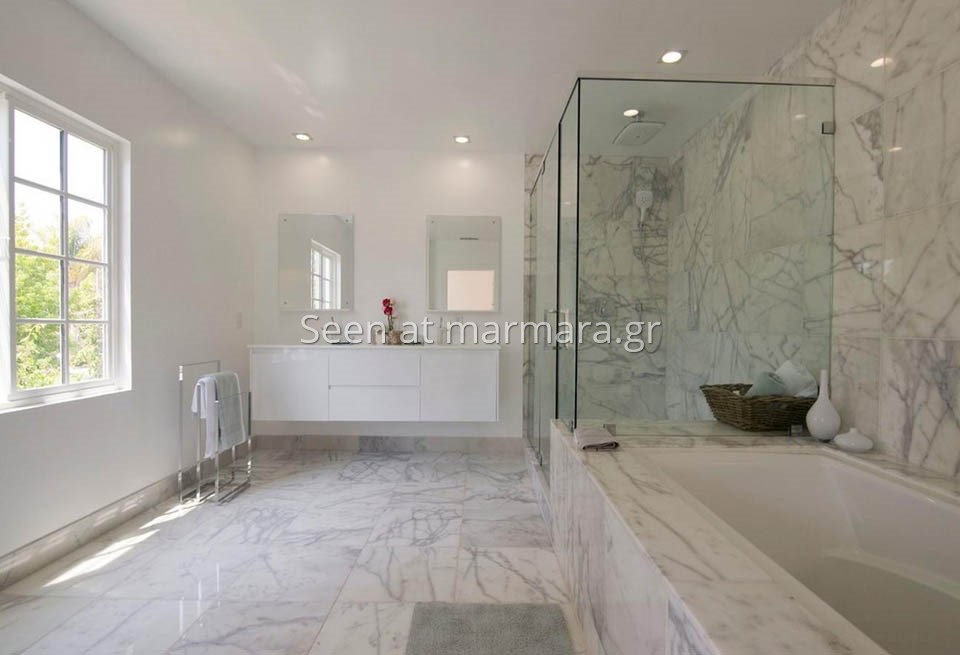
G. Heating units
Marble slabs of special dimensions are used lately in heating systems, since they have a high heat capacity and can transmit heat by radiation. The result is uniform heating, hygienic atmosphere and energy saving.
H. Other arts
Copies of classical sculptures, monuments, ecclesiastical works and fountains are some of the modern applications. Marble and stone artefacts also include a wide variety of decorative or daily use (eg emblems), as well as outdoor landscaping products based mainly on traditional standards, such as stone fountains and inlay elements for masonry or flooring. Fountains made of natural stone or white marble that match the pure and crystal-clear appearance of water, inlaid decorative elements with traditional influences etc. can offer impressive results in the organization of outdoor places.
Also, stone and especially marble are the ideal materials for creating some useful and functional objects with a developed aesthetic value. Bookbinders, decorative mirrors, stationery, lamps, decorative embossed plates are some of the objects that can be made of marble for an impressive interior decoration.
Today, there is a huge variety of marble and stone artefacts on the market, as many marble companies are actively involved in this field with great passion, in many cases with the collaboration of architects, artists and designers. Thus, the ingenuity of the scholar and the skill of the craftsman, the knowledge with experience, offer objects of high aesthetic value, perfectly functional and at affordable prices that can satisfy any requirement.
I. Plinths – Paving
The use of stone in the pavement of the streets has been particularly widespread over the past years throughout Greece and there are many stone roads that are still preserved. The cobblestone streets of many villages and large cities, as well as the beautiful cobbled streets of the islands, constitute a wonderful example of the best use of the natural rocks of the place.
The need for better quality of life in large but also in smaller urban centers still implies the use of natural stone, such as the traditional material that embellishes any construction, on stone pavers or paving.
At urban places formation (eg parks, squares, pavements, etc.) use shale, hard limestone rocks, marbles, granites, etc. in shapes of cubic or rectangular cross-section and of various dimensions. Typically, the top side of the slabs is treated (cut in the case of granite, gravel or comb in the case of limestone rocks), while the invisible side remains raw. Stones used in such applications must be robust, cracked, crushed, free of water and have high abrasion resistance. Both for the construction of paved and other decorative elements of communal places, rocks of different shades can be used, which with suitable combinations, give impressive aesthetic results. The play of soft natural colors made from stone to stone seems to be timeless and therefore irreplaceable.
Although there are many artificial materials that compete with the stone, it seems to be constantly gaining ground in the formation of communal places such as parks, squares, sidewalks, pedestrians, etc. Also, the artificially painted materials currently used in similar applications can not be compared with natural stone, because architects and builders have found its superiority, both aesthetically and technically.
J. External investment
Over the last few years, architects and builders have increasingly chosen natural decorative rocks for lining the exterior facades of buildings, since undoubtedly these materials have a better aesthetic effect than when the surfaces are bare or simply coated.
Thus, the need for specifications for the construction of exterior marble or other decorative rock formations has been created to ensure above all the safety of the construction and to exclude the drops of plates that can cause serious accidents. Unfortunately, such standards in our country have not been established so far, with the result that there are also many shortcomings. By applying stringent specifications, it is certain that all outer linings could have all the security guarantees and so the manufacturer could without distraction use more of marble in order to achieve, in addition to greater thermal insulation and watertightness, decorative compositions can not succeed with any other material.
The use of marble in exterior investment presents more technical difficulties because it requires special knowledge, great experience and specialized studies. In addition, the physical-mechanical properties of decorative rocks are essential for external investment because not all rocks are suitable for such applications.
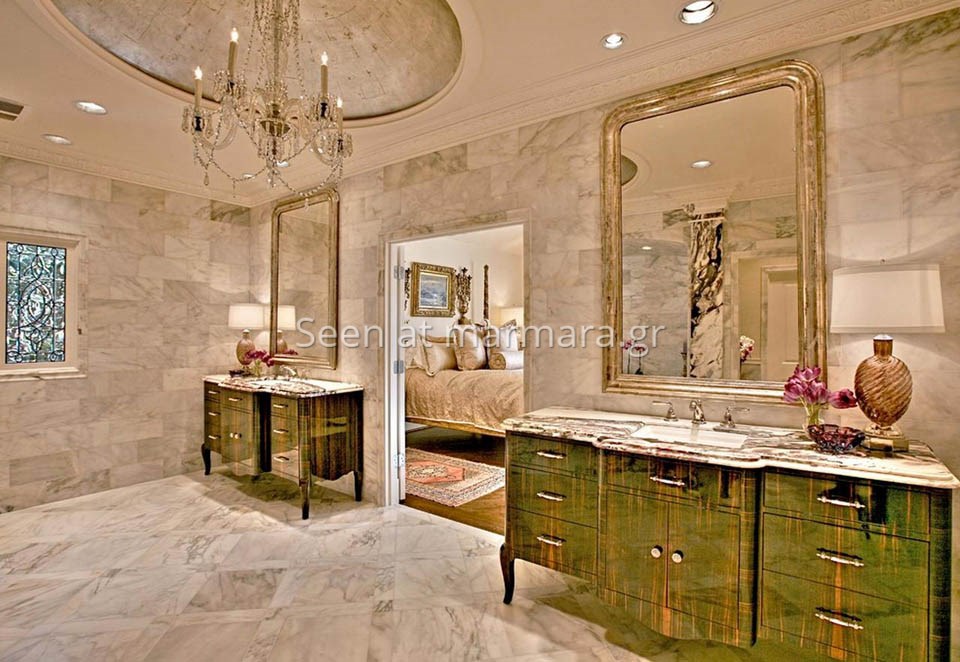
The basic requirements for the construction of a technically and aesthetically pleasing exterior investment are two:
Α. Strict selection of materials based on their physical and mechanical characteristics such as compressive strength, tensile strength, water absorption, etc. Natural rocks have different properties and are not as resistant to physical or chemical disintegration, temperature changes or atmospheric pollution that often prevails in large urban centers. For example fossil limestones are suitable for external coatings, because they have little resistance. The same is true for overseas quartzites, protuberant rocks or rocks containing sulphate minerals because they are more easily dissolved by the influence of water. On the contrary, rocks that perfectly meet the particular requirements of exterior coatings are those that have a compact crystal structure like genuine marbles, as well as most granites.
Β. Proper study of the external investment and its proper implementation. In the study that must precede the construction, the dimensions of the plates to be used, in the correct ratio between the surface of the slab and its thickness, as well as the weight of the slabs, must be determined. Also, the study should describe the way of supporting the plates to be made with metal stainless anchors, as well as the shape of the joints.
Generally, the outer linings should not be made with closed joints because the elastic deformations created by the application of additional loads on the wall cause stresses on the linings which are not delaminated when the joints are closed. On the contrary, open joints allow for greater tolerances in the dimensions of the lining plates. The existing joints of the building must correspond to similar joints in the investment, of a sufficient width, horizontal and vertical, which go deeper to the load-bearing wall. The width of the joints must be adjusted according to the temperature changes, the way the plates are supported and the properties of the lining materials and the wall.
The study of ortho-marble should take into account the thermal expansion of the structure, the influence of the wind, and even the chemical agents that may possibly influence the construction. The temperature changes are treated by fixing the plates with steel anchors without the interference of cement mortar. This increases the elasticity of the construction and avoids the creation of a compact continuity between two bodies with a different coefficient of thermal expansion.
Wind is considered to be the worst enemy of the resistance of the outer linings after the earthquake. Wind pressure can cause warp and / or cracking of the lining plates at their support points, so at the design stage, depending on the location of the structure, calculations are made based on specific safety factors.
Finally, the chemical agents that can affect a structure, are also the subject of the external ortho-mable. Carboniferous rocks have been shown to be affected by various chemical substances such as carbon dioxide and hydrogen sulfide that enter the atmosphere or tap water. Also, the effects of certain organic substances and the exhaust gases of various vehicles are devastating. In particular, hydrogen sulfide reacts with water and produces sulfuric acid which dissolves the calcium carbonate crystals. Furthermore, when water comes in contact with iron pyrite which may be contained in the rock, iron hydroxide is formed, resulting in rust stains on the surface of decorative rocks. Carbon dioxide is less dangerous than hydrogen sulfide, but it also causes problems on the surface of marble slabs. Along with rainwater, it forms carbonic acid which gradually erodes its carbonaceous components. This effect is significantly reduced if the surface of the plates is coated with a protective material (eg oxalic acid).
Therefore, the correct and accurate study of ortho-marble, and then the elaborate construction according to the rules of science and art, can give an outer coating that is stylish and durable. The surface of the slabs can be processed in a variety of ways, depending on the architectural requirements of the construction.